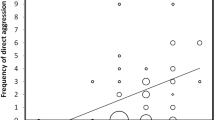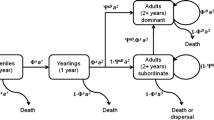Summary
A laboratory study on the ontogeny of social behavior in pikas (Ochotona princeps), an alpine lagomorph, was conducted to determine the role of early relationships between adult females and young and among siblings in the development of territorial and dispersal behaviors. Sex differences during development were examined because field studies have reported greater dispersal distances in young females than young males. At birth, females were significantly heavier than males. There were no sex differences in nursing frequency until after the 2nd week of age, when males initiated more nursing attempts than females. By the end of the weaning period (weeks 5 and 6), adult females became non-interactive with young, but aggression of young toward littermates and the mother increased until the eighth week. At this time, young males outweighed their sibling females. Young were dominant over their mothers by the age of 5 weeks, and young males were dominant over their sibling females.
Sex differences were observed in aggression, scent-marking, exploratory activity, and submissive vocalizations, with higher rates in young males, except for submissive vocalizations, which were higher in females (Table 2). Vocalizations and scent-marking behavior increased over time, and were positively correlated with interaction rates.
These data support the hypothesis that female young disperse farther than male young largely as the result of unsuccessful competition with male siblings for available territories close to the birthplance. A dispersal strategy for pkkas is proposed.
Similar content being viewed by others
References
Barash DP (1973) Territory and foraging behavior of pika (Ochotona princeps) in Montana. Am Midl Nat 89:202–207
Broadbrooks HE (1965) Ecology and distribution of the pikas of Washington and Alaska. Am Midl Nat 73:299–335
Conner D (1983) Acoustic communication in pikas (Ochotona princeps) Ph D thesis, University of Colorado, Boulder
Eisenberg J (1966) The social organization of mammals. Handb Zool 10:1–92
Fairbairn D (1978) Dispersal of deermice, Peromyscus manifulatus: proximal causes and effects of fitness. Behav Ecol Sociobiol 3:171–193
Harvey EB, Rosenberg LE (1960) An apocrine gland complex of the pika. J Mammal 41:213–219
Healy MC (1967) Aggression and self-regulation of a population in deermice. Ecology 48:377–392
Huck UW, Banks EM, Wang SC (1981) Olfactory discrimination of social status in the brown lemming. Behav Neur Biol 33:364–371
Kawamichi T (1976) Hay territory and dominance rank of pikas (Ochotona princeps). J Mammal 57:133–148
Krear R (1965) An ecological and ethological study of the pika (Ochotona princeps saxitilis bangs) in the Front Range of Colorado. Ph D thesis, University of Colorado, Boulder
Meaney C (1983) Olfactory communication in pikas (Ochotona princeps). Ph D thesis, University of Colorado, Boulder
Michener DR (1974) Annual cycle of activity and weight changes in Richardson's ground squirrel, Spermophilus richarsonii. Can Field Nat 88:409–413
Morrison DF (1967) Multivariate statistical methods. McGraw-Hill, New York.
Murray BG (1967) Dispersal in vertebrates. Ecology 48:975–978
Myers JH, Krebs CJ (1971) Genetic behavioral and reproductive attributes of dispersing field voles Microtus pennsyvanicus and Microtus ochrogaster. Ecol Monogr 41:97–110
Mykytowycz R, Goodrich BS (1974) Skin glands as organs of communication in mammals. J Invest Dermatol 62:124–131
Mykytowycz R, Hesterman ER, Gambale S, Dudzinski ML (1976) A comparison of the effectiveness of the odors of rabbits, Oryctolagus cuniculus in enhancement of territorial confidence. J Chem Ecol 2:13–24
Smith AT (1974) The distribution and dispersal of pikas: consequences of insular population structure. Ecology 55:1112–1119
Smith AT (1981) Territoriality and social behavior of Ochotona princeps. In: Myers K, MacInnes CD (eds) Proceedings of the world lagomorph conference. Guelph University Press, Guelph, pp 310–323
Smith AT (1983) Colonization in a pika population: dispersal versus philopatry. Behav Ecol Sociobiol 13:37–47
Southern HN (1948) Sexual and aggressive behaviour in the wild rabbit Oryctolagus cuniculus. Behavior 1:173–194
Svendsen GE (1979) Territoriality and behavior in a population of pikas (Ochotona princeps). J Mammal 60:324–330
Tapper SC (1973) The spatial organisation of pikas (Ochotona) and its effect on population recruitment. Ph D thesis, University of Alberta
Whitworth MR (1979) Population ecology of the pika (Ochotona princeps) in relation to density and climate. Sc M thesis, The Johns Hopkins University, Baltimore, Md
Whitworth MR, Southwick CH (1981) Growth of pika in laboratory confinement. Growth 45:66–72
Whitworth MR (1982) Maternal care, infant development and the ontogeny of social behavior in pikas. Ph D thesis, The Johns Hopkins University, Baltimore, Md
Whitworth MR (in press) Maternal care and behavioral development in pikas (Ochotona princeps). Anim Behav
Author information
Authors and Affiliations
Rights and permissions
About this article
Cite this article
Whitworth, M.R., Southwick, C.H. Sex differences in the ontogeny of social behavior in pikas: possible relationships to dispersal and territoriality. Behav Ecol Sociobiol 15, 175–182 (1984). https://doi.org/10.1007/BF00292972
Received:
Accepted:
Issue Date:
DOI: https://doi.org/10.1007/BF00292972




